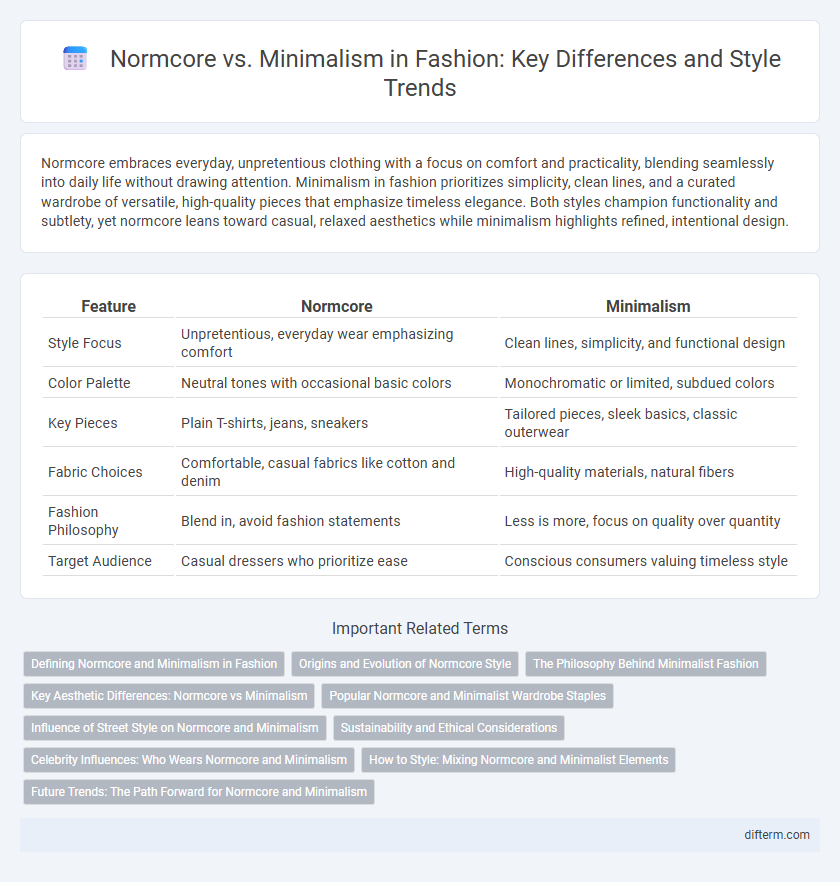Normcore embraces everyday, unpretentious clothing with a focus on comfort and practicality, blending seamlessly into daily life without drawing attention. Minimalism in fashion prioritizes simplicity, clean lines, and a curated wardrobe of versatile, high-quality pieces that emphasize timeless elegance. Both styles champion functionality and subtlety, yet normcore leans toward casual, relaxed aesthetics while minimalism highlights refined, intentional design.
Table of Comparison
| Feature | Normcore | Minimalism |
|---|---|---|
| Style Focus | Unpretentious, everyday wear emphasizing comfort | Clean lines, simplicity, and functional design |
| Color Palette | Neutral tones with occasional basic colors | Monochromatic or limited, subdued colors |
| Key Pieces | Plain T-shirts, jeans, sneakers | Tailored pieces, sleek basics, classic outerwear |
| Fabric Choices | Comfortable, casual fabrics like cotton and denim | High-quality materials, natural fibers |
| Fashion Philosophy | Blend in, avoid fashion statements | Less is more, focus on quality over quantity |
| Target Audience | Casual dressers who prioritize ease | Conscious consumers valuing timeless style |
Defining Normcore and Minimalism in Fashion
Normcore in fashion emphasizes unpretentious, everyday clothing that blends seamlessly into social environments, promoting comfort and practicality with items like plain t-shirts, jeans, and sneakers. Minimalism focuses on simplicity and functionality through clean lines, monochromatic palettes, and high-quality fabrics, aiming for timeless and versatile wardrobe staples. Both styles reject excessive ornamentation but differ in Normcore's casual blend-in approach versus Minimalism's refined, curated aesthetic.
Origins and Evolution of Normcore Style
Normcore fashion originated in the early 2010s as a reaction against the fast-paced, trend-driven industry, emphasizing ordinary, unpretentious clothing like plain tees, jeans, and sneakers to blend seamlessly into crowds. The style evolved from a cultural movement valuing comfort and practicality over ostentation, influenced by countercultural aesthetics and 1990s streetwear. Unlike minimalism, which focuses on sleek, streamlined designs and neutral color palettes, normcore embraces a deliberately average, anonymous look that challenges the concept of fashion identity.
The Philosophy Behind Minimalist Fashion
Minimalist fashion emphasizes simplicity, functionality, and intentionality, stripping away excess to highlight quality and timelessness. Rooted in the philosophy of "less is more," it promotes sustainability by favoring classic pieces that transcend fleeting trends. This approach contrasts with normcore's focus on blending in, as minimalism seeks deliberate elegance through curated, versatile wardrobes.
Key Aesthetic Differences: Normcore vs Minimalism
Normcore emphasizes casual, unbranded, and comfortable clothing that blends into everyday life, prioritizing practicality and a relaxed vibe. Minimalism features sleek, clean lines with a focus on high-quality fabrics, neutral color palettes, and timeless pieces designed for versatility and elegance. While normcore embraces an unpretentious, laid-back look, minimalism centers on refined simplicity and structured silhouettes.
Popular Normcore and Minimalist Wardrobe Staples
Popular normcore wardrobe staples include plain white sneakers, basic crewneck t-shirts, and relaxed-fit jeans that emphasize comfort and understated style. Minimalist wardrobes prioritize high-quality, versatile pieces such as tailored black blazers, neutral-toned cashmere sweaters, and classic leather ankle boots designed for timeless elegance. Both styles focus on simplicity but normcore leans towards casual, everyday wear while minimalism centers on refined, multifunctional essentials.
Influence of Street Style on Normcore and Minimalism
Street style heavily influences normcore by embracing unpretentious, everyday clothing that focuses on comfort and functionality, often featuring iconic brands and simple silhouettes. Minimalism draws from street style's clean lines and subdued color palettes, emphasizing simplicity and versatility in wardrobe choices. Both styles reflect urban culture's impact on fashion, blending practicality with understated aesthetics.
Sustainability and Ethical Considerations
Normcore emphasizes blending in with simple, comfortable clothing, often leveraging thrifted or vintage pieces to reduce waste and promote sustainable consumption. Minimalism advocates for a curated wardrobe of high-quality, timeless basics that prioritize durability and ethical production methods, minimizing environmental impact. Both styles encourage mindful purchasing habits that support sustainability and ethical fashion practices by valuing longevity over fast fashion trends.
Celebrity Influences: Who Wears Normcore and Minimalism
Celebrity influences shape the fashion landscape with figures like Steve Jobs embodying minimalism through his iconic black turtleneck and jeans, while stars like Jerry Seinfeld popularize normcore with unpretentious, casual attire. Minimalism is favored by celebrities such as Victoria Beckham and Gwyneth Paltrow, known for sleek, monochromatic ensembles that emphasize simplicity and elegance. Normcore attracts personalities like Kanye West, who embraces comfortable, ordinary clothing that blurs the line between fashion and everyday wear, promoting effortless style.
How to Style: Mixing Normcore and Minimalist Elements
Blend normcore's casual staples like plain t-shirts and relaxed jeans with minimalist pieces such as tailored blazers and monochrome accessories to create a balanced outfit. Pair neutral color palettes from minimalism with the everyday comfort and simplicity of normcore to achieve an effortlessly chic look. Prioritize clean lines and functional clothing items, ensuring both styles complement without overwhelming each other.
Future Trends: The Path Forward for Normcore and Minimalism
Future trends in fashion indicate a fusion of normcore's comfort-driven aesthetics with minimalism's clean lines and understated elegance, creating versatile wardrobes that prioritize sustainability and practicality. Innovations in sustainable fabrics and adaptive clothing designs are driving this convergence, appealing to consumers seeking both simplicity and functionality. The path forward for normcore and minimalism hinges on integrating technology and eco-conscious materials to redefine casual wear with timeless, effortless style.
normcore vs minimalism Infographic

 difterm.com
difterm.com